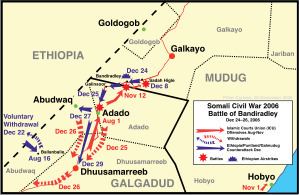N/A 500+ Dates 23 Dec 2006 – 25 Dec 2006 | N/A 1 helicopter gunship | |
 | ||
Similar Battle of Beledweyne, Battle of Jowhar, Battle of Mogadishu, Battle of Bargal, Battle of Jilib | ||
Battle of bandiradley
The Battle of Bandiradley in Somalia began on December 23, 2006, when Puntland and Ethiopian forces, along with faction leader Abdi Qeybdid, fought Islamic Courts Union (ICU) militants defending Bandiradley. The fighting pushed the Islamists out of Bandiradley and over the border south into Adado district, Galgadud region, by December 25.
Contents
- Battle of bandiradley
- Somali Civil War
- Prior Ethiopian interventions in the area
- Prelude to battle
- Battle
- Aftermath
- References
Somali Civil War
The battle has roots in the long-standing Somali Civil War. The areas of Galgudud and Mudug were drawn into the conflict arising between the state of Puntland, and the areas coming under the control of the ICU. While local leaders tried to organize into the autonomous state of Galmudug, over time it was forced to side with the forces of Puntland and Ethiopia in order to repel the ICU.
Prior Ethiopian interventions in the area
The borders of Galgadud and Mudug regions were under dispute with Ethiopia following the August 1982 border clashes. The towns of Balanbale and Goldogob had been under Ethiopian occupation from that time up until June 1988 when all troops were to pull back 9 miles from the disputed borders, and Ethiopia granted back the towns to Somalia.
On March 7–8, 1999, Ethiopia claimed it had made a cross-border incursion into Ballanballe searching for members of Al-Itihaad al-Islamiya (AIAI) who had reportedly kidnapped a person and stolen medical supplies, and denied reports of looting. Allegations from that time also claim Ethiopia was the supplier of various Somali warlords, while Eritrea was arming other warlords.
Prelude to battle
On August 14, 2006, local tribal leaders opposed to the advance of the ICU, as well as wishing autonomy from the state of Puntland, organized Ethio-Puntland Militias and put Abdi Qeybdid in charge of them.
On November 12, the ICU took the town of Bandiradley after a firefight with the forces of Abdi Qeybdid.
On November 13, the President of Puntland, General Adde Musa personally led 50 battlewagons to Galkayo to confront the Islamists.
On November 22, Ethiopia imposed a curfew on the town of Ballanballe and was searching residents entering or leaving the village in response to attacks on Ethiopian convoys in Somalia
On November 26, thousands of ICU troops were reported deploying in Abudwaq, within 15 km (9.3 mi) of the Ethiopian border. On November 27, troops were forcibly returning people who had fled to avoid fighting to their homes, reassuring them they would not come to harm.
On November 28, Ethiopian forces in the Galkayo, Mudug area were estimated to be about 500-strong, with over 100 vehicles including tanks. There was an exchange of gunfire and missiles. Afterwards, the ICU held a rally in Bandiradley, at which ICU commander Sheikh Sharif Sheikh Ahmed accused the Ethiopians of firing 12 missiles at Islamist positions.
On December 1, in Galkayo, it was reported 9 clerics of the Islamic Tabliq sect had been arrested under the orders of Colonel Abdi Qeybdiid.
On December 7–8, the militia of warlord Abdi Qeybdid took part in skirmishes against forces of the ICU near the small settlement of Sadah Higle between Bandiradley and Galkayo. This rapidly led to an exchange of shelling between Ethiopian and ICU troops. Hundreds of Ethiopian troops accompanied by forces from Puntland took up position near the town. Puntland forces claimed they had been provoked by rocket and mortar fire. ICU forces stated Ethiopian troops "started firing missiles toward our positions." At least one ICU fighter was claimed killed in the exchange.
On December 16, it was reported a local Islamic court named Imamu Shahfici was set up in Abudwaq. It urged Islamists to resist the Ethiopians
Further combat was kept in abeyance until the general outbreak of hostilities on December 20.
On December 19, 18 technicals and a large number of Ethiopian troops entered Ballanballe, Galgadud province, to reinforce troops already positioned in the town. Just prior to the battle, on December 22, Ethiopian troops departed Ballanballe where they had been in occupation for the past three months. This was reportedly done at the urging of the tribal elders, who did not wish fighting to break out between the ICU and Ethiopia in their town.
Battle
On December 22, Ethiopian troops were said to be amassing in Galkayo for what might turn into a second front of the war near Puntland. The following day, 500 Ethiopian troops and 8 tanks were reported to be heading towards Bandiradley. Islamist fighters retreated from their positions. They were pursued south to the area between Galinsoor and Bandiradley, where the Islamists were defeated. The ICU forces were further pursued to Adado in Galgadud, which they abandoned late on December 25, 2006.
Aftermath
The ICU abandoned the towns of Dhuusamareb and Abudwaq without fighting. In the wake of their withdrawal from Abudwaq, militias set up checkpoints and began firing their weapons.
